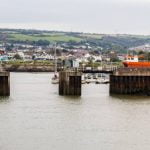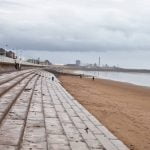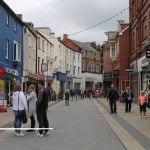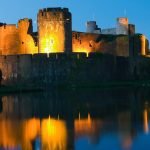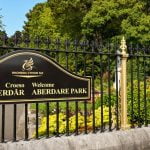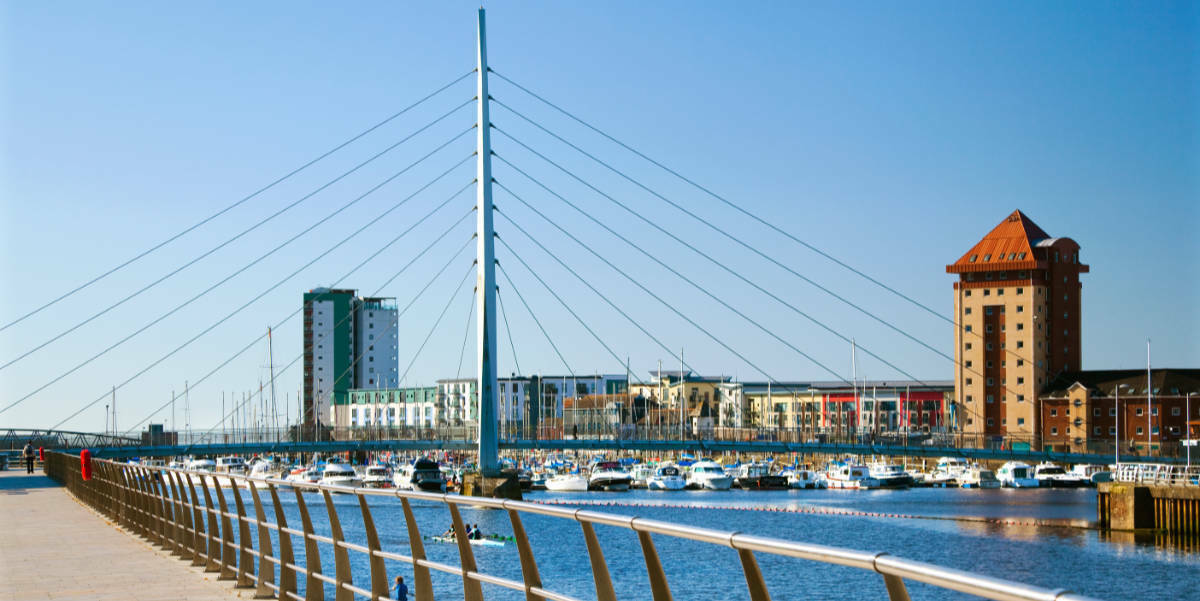
Swansea is located somewhere north of ancient Gŵyr and beyond the Vale of Glamorgan, the coastal city and county seat. Also known by its Welsh name of Abertawe; this coastal gem has grown to become the second biggest city in Wales.
We took the Five Minutes Spare microscope to this terrific town to find out what the best bits of Swansea are. What is there to do here? How do you find it? Is it picturesque and scenic like the rest of Wales? All will be revealed!
But first, let’s talk about history. Swansea… What’s that all about, then?
Stone Age Swansea?
Although it is reported the town actually began in the 12th century, there is evidence of stone age people living all along this coastline. Indeed, people of the time would have drawn major sustenance from the sea, so it understandable there would have been a settlement between here and the river outlet.
Archaeologists have made loads of discoveries on the Gower Peninsula, to the west past Mumbles Pier at the edge of Swansea Bay. Although they have found numerous Roman artefacts and know that this area was held around the 80AD mark, it is thought that Swansea itself didn’t appear until much later. It has also been speculated that Swansea was actually a Viking hideout.
Dark Age Swansea
The town name first appears as Aper Tyui (the mouth of the river Tawe) in 1150. This doesn’t mean it didn’t exist before that, only that records weren’t in operation yet. What we do know is that the Domesday Survey of England included only parts of Wales. So although it attempted to cover all of the holdings in the country it is inconclusive when talking about the origins of Swansea.
So yes, there may have been people living in the natural cove of Swansea Bay as long ago as the stone age. However, historians don’t know that it was a complete town until the 12th century. In terms of ages of places, Swansea isn’t that old by comparison to the rest of the UK.
We did find one source that has Swansea as a settlement dating from around 3000 BC. They date this using evidence from the ‘red lady’, an important Neolithic corpse found in the nearby peninsula.
So Where Did Swansea Start?
As we mentioned above, Swansea is first talked about at the end of the 12th century. It is thought that it grew up around a Viking trading post. More likely, the Vikings would have raided along this coast and may have needed a place to stop. The chief purpose behind them invading parts of Britain in the first place was to find good land… Not to pillage, as everyone thinks. Swansea is good land. It is highly probable that the Vikings took the area for farmland. They weren’t all bad.
Records from roughly 1000 AD have Swansea as a Norse fort built and named for ‘Swein’. Local Histories record the island called Sweins Ey, which would have meant Swein’s Island in the old tongue. However, nobody knows who Swein is…
Now… We did a little digging and have a suggestion of our own… Sweyn Forkbeard was a Dane born in 960 AD, famed as England’s Forgotten King. He ruled for five whole weeks in 1013 and died before he could be crowned. We would hazard a guess that the real old spelling of Swansea might be Sweyn’s Ey… The timeline even matches. Just a thought.
Early Swansea
Swansea was made a borough in 1215 in which the town was named ‘Sweyneshe’. A 1314 charter followed granting more rights to the people. After the Norman invasion, it grew to become of important size, with the Norman Overseer building Worcester Place and the town benefiting from the fortifications of the castle.
At the beginning of the fourteenth century the ditch and wooden ramparts were replaced with stone. It was burned to the ground several times over the years, with 1402 being the last recorded ransacking. The Rebellion of Owain Glendower was the last time it was burned. Despite all of this it had a population of around a thousand in those days. Back then, any more than ten houses were almost a city.
Uprising
An aside for a moment to talk about that uprising. Owain is considered to be a national hero in some parts of Wales. He was the last true ruler of the ‘free country’ of Wales before it joined the Union. He is revered for masterminding a rebellion against the English throne more than 600 years ago. He is the Welsh version of William Wallace or Guy Fawkes. A hero of the people that deserves (at least) a paragraph in the annals of Swansea history.
Basically, if he burned down the town of Swansea it is highly likely that he is the scapegoat. Or that it was being ‘occupied’ at the time. We’re not very sure – but we know enough to give the man a little more respect than some of the other history pages. If you want to learn more about Owain and his doomed campaign, head over to the Welsh Wales for more info. It’s an interesting read for those that can handle nationalism…
As the town grew a shipyard appeared. The port became gradually more and more important to the surrounding area. Eventually, Swansea became known for shipbuilding, as well as exporting things like meat, dairy, leather and wool to England.
The Black Death
Swansea was a port town and was highly affected by the bubonic plague. Some estimates are that a full half of the population died around 1348. It was a big town with no sewer system that largely depended on the water of the river for survival. As well as the plague, it suffered Cholera outbreaks on the regular. Two are reported in the eighteenth century which led to the establishment of the poor man’s medical dispensary.
Actually, Sarah Woodbury accounts that there were three types of plague in Wales. Bubonic, which carried a death toll of between 30 and 75%. To put that into perspective that’s between 3 and 8 people out of ten! The Pneumonic plague came next, carrying a death rate of 90-95%, and the third type of plague was Septicaemia, all carried in on the same boats. There was no treatment for the third type of plague. It killed 100% of those that caught it. Given these numbers, it is surprising the town survived.
Anyway between these three forms, all of which were caused by the same bacterial infection, it is thought that a third of Europe’s population died. One hellish report has a boy who stands to inherit the estate from a father in Wales, dying before he could get to court. The brother of the original estate owner also died before he could collect. A third brother was left with the entire estate. Nobody was left alive to work the land and it was deemed worthless.
Plague Fallout
It was a horrendous time to be alive. The plague in England and Wales was followed by famine as nobody was left alive to grow food… As you can imagine, the working class was hit far harder than the rich. Unfortunately, history doesn’t count the lives of we peasants as often as it records the losses of the upper classes.
In the 14th-15th century, Swansea had a history of porcelain making. Crafters worked and lived here, close to the docks that might export their goods. Swansea was also known for oyster harvesting, to the point where Oystermouth Castle was named after this popular pastime. Oyster collecting was probably what attracted the Vikings to colonise the area in the first place. A ready food source such as this would have been a huge attraction.
Weirdly, during the late 16th and early 17th centuries, Wales became a time of witches and spellcraft. New research dug up in 2018 showed that 42 ‘people’ (they would have all been women) were found guilty of witchcraft in Wales, within that hundred-year period. It seems baffling that we might still be accusing people of witchcraft in the 17th century in Britain… but we were. While America prattles on about losing the thirteen witches in Salem, Britain was rounding up any women that were ‘a problem’ under accusations of witchcraft.
18th Century Swansea
Time passed, and the town recovered, but the lessons of the plague were eventually learned. In the 1700s the industrial revolution ravaged the town in a big way. It became the world’s best-known copper smelting city. The whole county was filled with copper, and the Cornish started exporting their copper there to add to the pile. America began sending copper, and so did everywhere else. In the following hundred years, the population grew by a reputed 500 times.
Over the years, Swansea has smelted its way through tonnes of material, but it was once called ‘Copperopolis’ because of how much copper it has gotten through. The amount of metal that passed through this city made it the most powerful port in the world for a handful of years.
When smaller mines and foundries were opened in America after the turn of the century the mines in Britain went into decline. They weren’t able to meet the costs saved on exportation fees. A boat loaded with copper was a heavy boat and taking a heavy boat across the sea was dangerous. As soon as the new colonists were able to find copper in the new world Swansea started to fall out of favour.
The Fall Of Copperopolis
After 1801 the price of copper hit a peak and started to fall. Its popularity of it fell off, as well. Swansea changed to a market town, a coal town, and then an important steel town. Everything that could be smelted, was smelted, in Swansea. It was because of this that the Germans targeted them with the Luftwaffe in February of 1941.
The Swansea Blitz took place over three nights. It resulted in the deaths of 230 people and the injury of a further 400. The Nazis were aiming for the port and docks to try and stop the coal processing. Unfortunately, the docks are in the heart of the town.
Remember too that Swansea wasn’t a city up until the sixties. It was given this status to mark Prince Charles becoming the Prince of Wales. Although still a busy port, metalworking has fallen in demand since the war. Nowadays, Swansea stands as a testament to the way towns rise and fall alongside the popularity of the industry. Still, a coastal town will likely always stand in its place… and it has contributed more than its share to Great Britain to have earned its status as the second-largest city in Wales.
A Bit of Swansea Trivia
We always like to list a few bits of trivia to lighten things up after the history lesson. here are a few of our favourites
- Gower Peninsula was voted the UK’s first ‘Area of Outstanding Natural Beauty.
- A local dog called Jack reportedly rescued 27 people from the water on the docks and riverbanks from 1930-1937. There’s a plaque In the museum commemorating him.
- Swansea was the first Welsh city to have its own Monopoly board. Great if you fancy owning Morgans Hotel but don’t have the readies.
- One of the earliest human skeletons to be discovered in Britain was found near Swansea. The remains of The Red Lady of Paviland were found in 1823 at Gower Peninsula. So Called as the remains were dyed with Red Ocre. Oh and by the way – you guessed it the remains are from a man.
Famous People From Swansea
There are so many we could bore you to tears listing them. So instead here are a select few…
Footballers
Trevor Ford – Who began his playing career with Swansea Town and also won 38 times for Wales between 1946 & 1956. He was transferred From Aston Villa to Sunderland in 1950 for a then British record fee of £30,000
John Charles – who scored 15 goals for wales in 38 appearances. He played for Leeds United from 1949 to 1957 when he was transferred to Juventus for a then quite staggering £65,000. The previous record fee was £35,000!
Dean Saunders – He also played for Wales and picked up an FA Cup Winners Medal with Liverpool in 1992. He was sold to Aston Villa For £2.5m the following season then a Villa transfer record. Do you see a pattern here…
Rugby Players
Alun Wyn Jones – Welsh International and four times (and possibly counting) British & Irish Loins Selection.
Daniel Biggar – Another Welsh International and also a Lions selection.
Musicians & Writers
Drummer Terrence Williams who played with Dire Straits
Screen Writer Russell T Davies is probably best known for his work on Dr Who.
Actors & Performers
Harry Secombe Goon Show member who also had numerous acting roles as well as a successful singing career.
Hollywood Actress Catherine Zeta-Jones – who has appeared in films such as Oceans Twelve Rock Of Ages & Dads Army.
Comedian & Actor Rob Brydon who most famously plays himself!
Ok, we said we would keep it brief so sorry if we missed your favourite. Anyway on to some attractions
Swansea Attractions
Fast forward a few years – and how is Swansea now? It’s a bit of a tourist attraction for its clement weather and its situation on the southern coast. The Bay is beautiful, the piers and docks have been restored, and it shares a long industrial heritage with more than a handful of other British towns. It is a destination people think of with nostalgia… and it will continue to attract visitors until the next resurgence in copper…
In the meantime, we listed some of our favourite Swansea attractions for you to peruse. So if you happen to be spending any time here, there are a few sights you should make space to see.
The Marina
The Marina is a fabulous place to stroll around – even if you are not rich enough to have arrived by Yacht. It is located at the mouth of the River Tawe and was awarded Blue Flag status in 2005. Thanks to the Swansea Barrage it now resembles a lake and there are berths for literally hundreds of boats. Have a wander around and look at the beautiful craft or enjoy a drink in one of the many cafes etc that adorn the area.
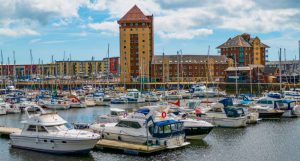
Image: David Hughes/Shutterstock.com
Swansea Castle
This medieval castle is in ruins today, but parts of it can at least still be seen. Since the 15th century rebellion that brought most of the walls down it hasn’t seen enough restoration. That being said, parts of it still stand. To be fair; it has been in the same place since the Vikings built that first fort all the way back in 1000BC, so it is doing pretty well.
To this day they give a good tour. Go along and check it out. If you feel like one ruined castle isn’t enough of a sight, then take yourself along to Oystermouth Castle. This 14th-century beauty dominates the skyline on the side of Mumble’s Hill. It is surrounded by its own nature reserve and all the rugged beauty of the Welsh coastline. They also hold events throughout the tourist season.
If historical attractions are your favourite type of sight then head over to St. Mary’s Church while you are in town. The church was founded in 1332 by missionaries but has been burned to the ground on more than one occasion. It is still decorated in the gothic style, but nowadays they build it out of stone. It is estimated this is the 6th actual church to take the same name and stand on this sight… but since 1000 AD that’s still a good record. Especially when you consider that this church is still in use, to this very day.
Swansea Museum
If you really want to learn about the culture of this industrious city then this is where you should go to do it. It talks you through the history of the whole area, as well as running different exhibitions all throughout the year. There are loads of photographs of the old town, too.
Another fun (but important) museum in the area is the Waterfront Barge Museum. It has a history going back to 1842, with huge contributions to history being investigated. The Dylan Thomas Centre is a third option for exhibitions and learning while you are on holiday… because some people are gluttons for punishment.
For those with specialised historical taste, Swansea has an Egypt Centre and nobody is quite sure why. It is filled with interesting exhibits, hosts events, and is run by both the university and a network of volunteers. It was founded in the nineties when a small collection was held by the museum.
Beaches, Bays and a Pretty Peninsula
The top-rated attraction in Swansea on Trip Advisor is the Gower Peninsula, which lies to the west of town, beyond the bay. This peninsula is quickly followed by Three Cliffs Bay and Oxwich Bay. You also have Llangennith Beach and Mumbles Hill nature reserves for outdoor exploration. There are literally too many bays, beaches, and inlets for us to list here.
Swansea Football Club
Swansea City is the representative soccer team of the area. You can find them in Liberty Stadium where you can also take the tour. This same stadium is home to the Ospreys Regional Rugby club. Swansea RFC is the official league-playing rugby team though… It’s a big thing in Wales. They have both men’s and women’s teams.
If you are looking for something to do in Swansea with the kids, then try the leisure centre for a cheap day out. Swansea Indoor Market is a good place to take them for their ever-growing need of new clothes. It also gives you some shopping time. If they love learning about nature then Plantasia allows them to learn about tropical plants they won’t find anywhere else.
If you fancy a picnic in the park then Singleton park is a good bet. Alternatively, Swansea has its very own beach for sandcastle-building fun. There is so much to do in Swansea with kids it’s a great place to live if you have a family. It’s also the kind of place where family holidays by the sea make the best memories.
If all else fails, you can drop them off at the Odeon and go do your own thing in the town centre. Kids love cinemas and parents love peace… a match made in heaven. Simcock Farm on the outskirts of town offers another option for kids… they are a historic farm with its very own petting zoo… perfect for the younger patron. They run corn mazes, Halloween attractions, and summer fun days out throughout the season.
Where to Eat, Drink, and Party in Swansea
The best places to eat in Swansea depend on what style of food you want. La Parmigiana is great for Italian food but Bouchon De Rossi is best for French. Similarly, if you want some good seafood the Gower Seafood Hut is the best, but the Lotus is great for a Chinese meal. If you just want something to nibble while you get drunk? Try Revolution Bar. The food is always better than you expect it to be for pub grub.
So what about nightlife? Again, Swansea has an eclectic mix of some of the best places for any taste. The Zinco Lounge has a nice, suave feel to it if you want to impress some potential clients. Kon-Tiki is cool for a laugh and a good time. The Peppermint bar is one of the more upbeat in the city.
How to Get to Swansea
How do you actually get to Swansea? Don’t worry, we got you.
By Road
If you head west out of London and then turn south onto the M4 you will eventually reach Wales. Go west, and then a little more south-west, and then west again, and you will eventually reach this seaside town.
On The Train
Swansea Train Station is on the Great Western Rail travel map. You can access it from London, but it will cost you, perhaps in blood.
By Sea
Swansea is a renowned port town and you can get ferries to and from Ireland from their docks. Ferry Online has more information.
By Air
Swansea Airport is a real place but you can’t fly to it or from it unless you happen to own a private plane or helicopter. It is the type of airfield you go for those flying lessons you got as a gift voucher for your birthday that year.
Got Five Minutes?
If you still find yourself with a spare few minutes, you can find loads of cool trivia and quizzes over at Five Minutes Spare HQ. Maybe we can teach you about your own town? Perhaps you want to take up a new hobby? Whatever your calling you should be able to find it… we have a little something for everyone, and that includes you!
